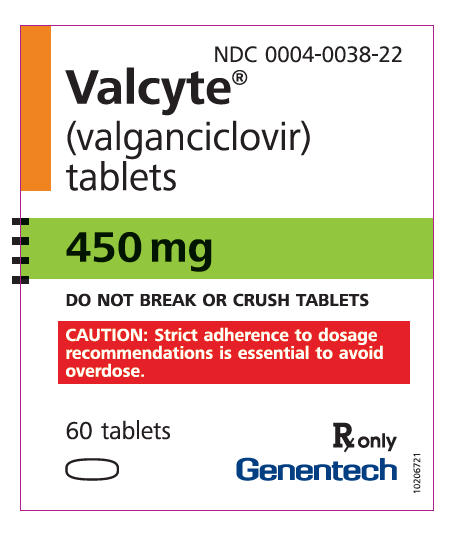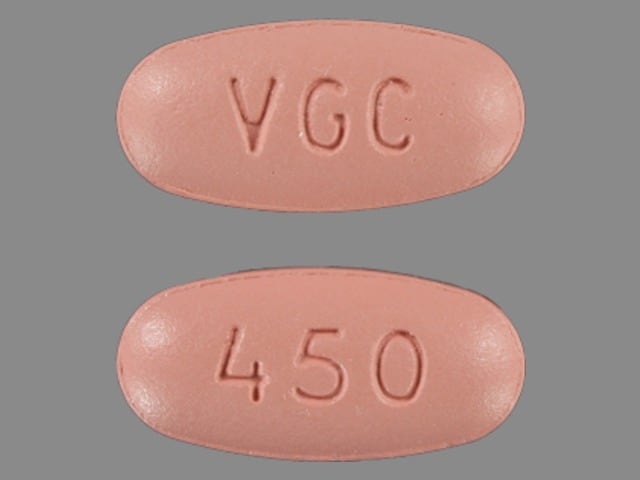Valcyte
Generic name: valganciclovir
Drug class: Purine nucleosides
Medically reviewed by A Ras MD
What is Valcyte?
Valcyte is a prescription antiviral medicine. In adults, Valcyte tablets are used to treat cytomegalovirus (CMV) retinitis in people who have acquired immunodeficiency syndrome (AIDS). When CMV virus infects the eyes, it is called CMV retinitis. If CMV retinitis is not treated, it can cause blindness; to prevent CMV disease in people who have received a kidney, heart, or kidney-pancreas transplant and who have a high risk for getting CMV disease.
Valcyte does not cure CMV retinitis. You may still get retinitis or worsening of retinitis during or after treatment with Valcyte. It is important to stay under a healthcare provider’s care and have your eyes checked at least every 4 to 6 weeks during treatment with Valcyte.
In children, Valcyte tablets or oral solution are used to prevent CMV disease in children 4 months to 16 years of age who have received a kidney transplant and have a high risk for getting CMV disease, to prevent CMV disease in children 1 month to 16 years of age who have received a heart transplant and have a high risk for getting CMV disease.
It is not known if Valcyte is safe and effective in children for prevention of CMV disease in liver transplant, in kidney transplant in infants less than 4 months of age, in heart transplant in infants less than 1 month of age, in children with AIDS who have CMV retinitis, and in infants with congenital CMV infection.
Description
VALCYTE contains valganciclovir hydrochloride (valganciclovir HCl), a hydrochloride salt of the L-valyl ester of ganciclovir that exists as a mixture of two diastereomers. Ganciclovir is a synthetic guanine derivative active against CMV.
VALCYTE is available as a 450 mg tablet for oral administration. Each tablet contains 496.3 mg of valganciclovir HCl (corresponding to 450 mg of valganciclovir), and the inactive ingredients microcrystalline cellulose, povidone K-30, crospovidone and stearic acid. The film-coat applied to the tablets contains Opadry Pink®.
VALCYTE is also available as a powder for oral solution, which when constituted with water as directed contains 50 mg/mL valganciclovir free base. The inactive ingredients of VALCYTE for oral solution are sodium benzoate, fumaric acid, povidone K-30, sodium saccharin, mannitol and tutti-frutti flavoring.
Valganciclovir HCl is a white to off-white crystalline powder with a molecular formula of C14H22N6O5∙HCl and a molecular weight of 390.83. The chemical name for valganciclovir HCl is L-Valine, 2-[(2-amino-1,6-dihydro-6-oxo-9H-purin-9-yl) methoxy]-3-hydroxypropyl ester, monohydrochloride. Valganciclovir HCl is a polar hydrophilic compound with a solubility of 70 mg/mL in water at 25°C at a pH of 7.0 and an n-octanol/water partition coefficient of 0.0095 at pH 7.0. The pKa for valganciclovir HCl is 7.6.
The chemical structure of valganciclovir HCl is:

All doses in this insert are specified in terms of valganciclovir.
What is the most important information I should know about Valcyte?
Valcyte can cause serious side effects, including:
- Blood and bone marrow problems. Valcyte can affect the bone marrow lowering the amount of your white blood cells, red blood cells, and platelets and may cause serious and life-threatening problems.
- Kidney failure. Kidney failure may happen in people who are elderly, people who take Valcyte with certain other medicines, or people who are not adequately hydrated.
- Fertility problems. Valcyte may lower sperm count in males and cause fertility problems. Valcyte may also cause fertility problems in women. Talk to your healthcare provider if this is a concern for you.
- Birth defects. Valcyte causes birth defects in animals. It is not known if Valcyte causes birth defects in people. If you are a female who can become pregnant, you should use effective birth control during treatment with Valcyte and for at least 30 days after treatment. If you are pregnant, talk to your healthcare provider before starting treatment with Valcyte. If you are a female who can become pregnant, you should have a pregnancy test done before starting Valcyte.
- Tell your healthcare provider right away if you become pregnant during treatment with Valcyte.
- Males should use condoms during treatment with Valcyte, and for at least 90 days after treatment, if their female sexual partner can become pregnant. Talk to your healthcare provider if you have questions about birth control.
- Cancer. Valcyte causes cancer in animals and may potentially cause cancer in people.
Your healthcare provider will do regular blood test during treatment with Valcyte to check you for side effects. Your healthcare provider may change your dose or stop treatment with Valcyte if you have serious side effects.
Who should not take Valcyte?
Do not take Valcyte if you have had a serious allergic reaction to valganciclovir, ganciclovir or any of the ingredients of Valcyte. See the end of this leaflet for a list of the ingredients in Valcyte.
What should I tell my healthcare provider before taking Valcyte?
Before you take Valcyte, tell your healthcare provider about all of your medical conditions, including if you:
- have low blood cell counts
- have kidney problems
- are receiving hemodialysis
- are receiving radiation treatment
- are pregnant or plan to become pregnant.”What is the most important information I should know about Valcyte?”
- are breastfeeding or plan to breastfeed. It is not known if Valcyte passes into your breast milk. You should not breastfeed if you take Valcyte.
- You should not breastfeed if you have Human Immunodeficiency Virus (HIV-1) because of the risk of passing HIV-1 to your baby.
- Talk to your healthcare provider about the best way to feed your baby.
Tell your healthcare provider about all the medicines you take, including prescription and over-the-counter medicines, vitamins and herbal supplements. Valcyte and other medicines may affect each other and cause serious side effects. Keep a list of your medicines to show your healthcare provider and pharmacist.
- You can ask your healthcare provider or pharmacist for a list of medicines that interact with Valcyte.
- Do not start taking a new medicine without telling your healthcare provider. Your healthcare provider can tell you if it is safe to take Valcyte with other medicines.
How should I take Valcyte?
- Take Valcyte exactly as your healthcare provider tells you. Your dose of Valcyte will depend on your medical condition.
- Adults should only take Valcyte tablets. Children may take either Valcyte tablets or oral solution.
- Take Valcyte with food.
- Do not break or crush Valcyte tablets. Avoid contact with your skin or eyes. If you come in contact with the contents of the tablet or oral solution, wash your skin well with soap and water or rinse your eyes well with plain water.
- If your child is prescribed Valcyte for oral solution, your pharmacist will give you oral dosing dispensers to measure your child’s dose of Valcyte for oral solution. To be sure you receive the prescribed dose, it is important to use the dispenser provided to you. See the detailed instructions for use below that come with Valcyte. Ask your pharmacist if you have any questions. If you lose or damage your oral dispensers and cannot use them, contact your pharmacist.
- If you take too much Valcyte, call your healthcare provider or go to the nearest hospital emergency room right away.
What should I avoid while taking Valcyte?
Valcyte can cause seizures, dizziness, and confusion. You should not drive a car or operate machinery until you know how Valcyte affects you.
What are the possible side effects of Valcyte?
Valcyte may cause serious side effects, including:
See “What is the most important information I should know about Valcyte?”
The most common side effects of Valcyte in adults include:
- diarrhea
- fever
- fatigue
- nausea
- shaky movements (tremors)
- low white cell, red cell and platelet cell counts in blood tests
- headache
- sleeplessness
- urinary tract infection
- vomiting
The most common side effects of Valcyte in children include:
- diarrhea
- fever
- upper respiratory tract infection
- urinary tract infection
- vomiting
- low white blood cell counts in blood tests
- headache
These are not all the possible side effects of Valcyte.
Call your doctor for medical advice about side effects. You may report side effects to FDA at 1-800-FDA-1088.
General information about the safe and effective use of Valcyte
Medicines are sometimes prescribed for purposes other than those listed in a Patient Information leaflet. Do not use Valcyte for a condition for which it was not prescribed. Do not give Valcyte to other people, even if they have the same symptoms you have. It may harm them. You can ask your pharmacist or healthcare provider for information about Valcyte that is written for health professionals.
How should I store Valcyte?
- Store Valcyte tablets at room temperature between 68°F to 77°F (20°C to 25°C).
- Store Valcyte for oral solution in the refrigerator between 36°F to 46°F (2°C to 8°C), for no longer than 49 days.
- Do not freeze.
- Do not keep Valcyte that is out of date or that you no longer need.
Keep Valcyte and all medicines out of the reach of children.
What are the ingredients in Valcyte?
Active ingredient: valganciclovir hydrochloride
Inactive ingredients for tablets: microcrystalline cellulose, povidone K-30, crospovidone, and stearic acid. The film-coating applied to the tablets contains Opadry Pink.
Inactive ingredients for oral solution: sodium benzoate, fumaric acid, povidone K-30, sodium saccharin, mannitol and tutti-frutti flavoring.
Label
PRINCIPAL DISPLAY PANEL – 450 MG BOTTLE CARTON
- NDC 0004-0038-22
- Valcyte®
(valganciclovir)
tablets - 450 mg
- DO NOT BREAK OR CRUSH TABLETS
- CAUTION: Strict adherence to dosage
recommendations is essential to avoid
overdose. - 60 tablets
Rx only - Genentech
- 10206721


SRC: NLM .
